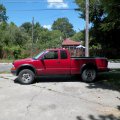Ernest Shaw
Retired machinist
I'm starting out with a 1998 S10 ZR2 that I've had for a few years. The truck isn't anything special, just a project vehicle. I drove it a few years and age started catching up with it so I thought I'd start collecting some parts for a build. Good thing I did. One day I went out to start it and out of the blue the starter would grind whenever I tried to start it. Closer inspection showed that one of the starter mounting bolts was missing. I got one and went to replace it and found that the reason the bolt was missing was because the block was cracked were it goes in letting it work its way out. Ouch! Instead of trying to engineer a fix I decided that since it had so many miles on it, about 230K that I'd set it aside and collect parts for a v8 swap since the engine was coming out anyway. I have quite a stockpile of parts for it so I decided it's time to start using some of them. This is a pic of what I started with.


















